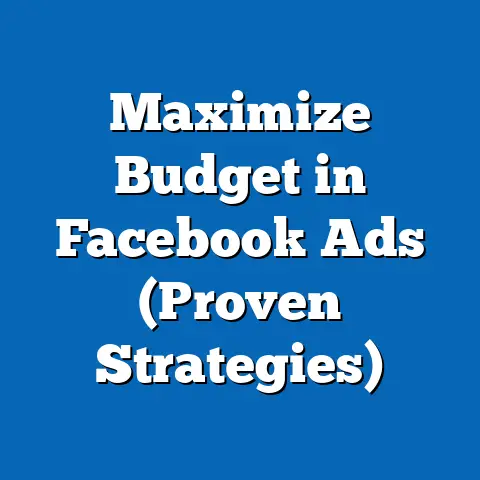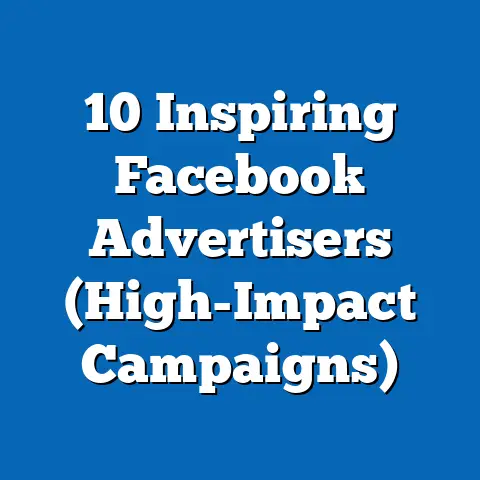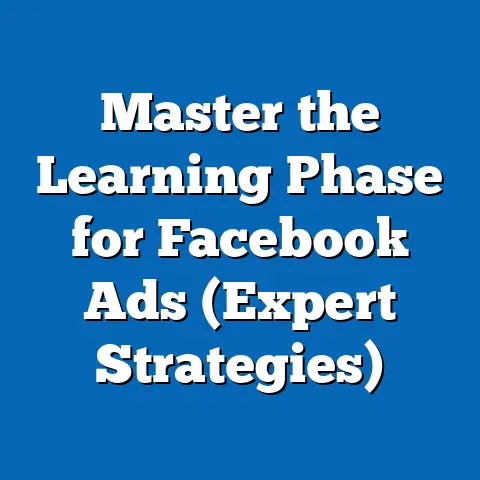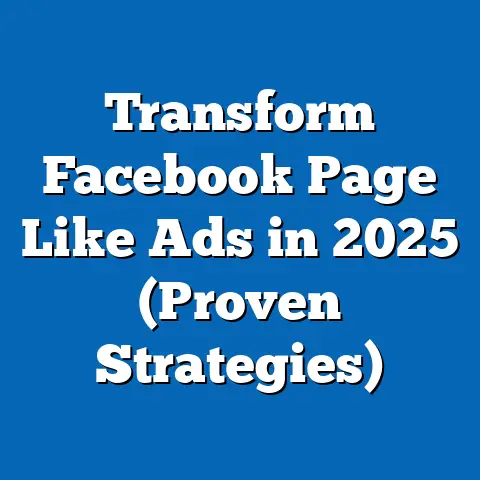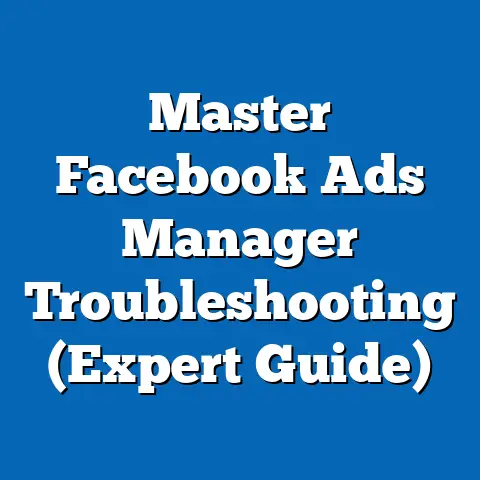Master Targeted Facebook Job Ads (Proven Strategies)
In the late 19th century, during the Industrial Revolution, businesses in rapidly growing urban centers faced an unprecedented challenge: attracting skilled labor in a competitive market. Factories and enterprises resorted to posting notices in public squares, newspapers, and community boards, often tailoring their messages to specific demographics or trades to maximize reach. This rudimentary form of targeted advertising laid the groundwork for modern recruitment strategies, where precision and audience segmentation are paramount.
Section 1: The Current Landscape of Facebook Job Ads
1.1 Usage and Reach
Facebook’s vast user base makes it a powerful tool for recruitment, particularly for roles requiring niche skills or specific demographic targeting. According to a 2022 report by Hootsuite, 74% of job seekers use social media platforms to search for opportunities, with Facebook being a top choice due to its accessibility and robust advertising tools. As of 2023, businesses posted over 1.5 million job ads monthly on the platform, reaching an estimated 200 million users actively seeking employment (Facebook Business Insights, 2023).
The platform’s ability to segment audiences by age, location, education, interests, and even behavioral data allows recruiters to craft highly targeted campaigns. For instance, a tech company seeking software engineers can target users with interests in coding communities or specific educational backgrounds. This precision reduces wasted ad spend and increases the likelihood of attracting qualified candidates.
1.2 Effectiveness Metrics
Current data indicates that targeted Facebook job ads outperform traditional online job boards in certain metrics. A 2022 study by the Society for Human Resource Management (SHRM) found that 62% of recruiters reported higher application rates from Facebook ads compared to other platforms like LinkedIn for entry-level and mid-tier positions. Additionally, the average cost-per-click (CPC) for job ads on Facebook is approximately $0.70, significantly lower than LinkedIn’s $5.00 CPC for similar campaigns (AdEspresso, 2023).
However, effectiveness varies by industry and role. While blue-collar and service industry positions see high engagement due to Facebook’s broad user base, executive-level roles often require more specialized platforms. Limitations in data also exist, as self-reported user information on Facebook may not always reflect accurate qualifications or career intentions.
Section 2: Proven Strategies for Mastering Targeted Facebook Job Ads
2.1 Audience Segmentation
The cornerstone of effective Facebook job ads lies in precise audience segmentation. Using the platform’s Ads Manager, recruiters can define target audiences based on demographics (e.g., age 25-34, location within 50 miles of a city), interests (e.g., followers of industry-specific pages), and behaviors (e.g., users who have recently searched for job-related content). A 2021 case study by a retail chain showed a 40% increase in qualified applications when ads were segmented by local zip codes and interests in retail careers (Facebook Case Studies, 2021).
Recruiters should also leverage “lookalike audiences,” a feature that targets users similar to existing employees or past applicants. This method uses machine learning to identify patterns in successful hires, increasing the likelihood of reaching suitable candidates. However, over-segmentation can limit reach, so a balance between specificity and scale is crucial.
2.2 Compelling Creative Content
Visual and textual content significantly impacts ad performance. Ads with high-quality images or short videos showcasing workplace culture or employee testimonials achieve 30% higher click-through rates (CTR) compared to text-only ads (Social Media Examiner, 2022). For example, a logistics company reported a 25% uptick in applications after using a video ad featuring current drivers discussing job benefits.
Job descriptions in ads should be concise, highlighting key benefits like salary ranges, flexible hours, or career growth opportunities. Including a clear call-to-action (CTA) such as “Apply Now” with a direct link to an application form reduces friction in the process. Testing multiple ad variations through A/B testing is recommended to identify the most effective messaging.
2.3 Budget Optimization and Timing
Facebook’s advertising algorithm rewards consistent engagement, making strategic budgeting essential. Recruiters should allocate budgets based on campaign objectives—higher for urgent roles and lower for ongoing talent pipelines. Data from AdEspresso (2023) suggests that ads running for 7-14 days with a daily budget of $10-$20 per ad set achieve optimal reach and engagement for small to medium-sized businesses.
Timing also plays a critical role. Posting ads during peak user activity times—typically evenings and weekends—can increase visibility by up to 15% (Sprout Social, 2023). Additionally, aligning campaigns with seasonal hiring trends (e.g., retail spikes during holidays) maximizes impact.
Section 3: Projected Trends in Facebook Job Advertising
3.1 Growth in Mobile-First Recruitment
With 98.5% of Facebook users accessing the platform via mobile devices (Statista, 2023), the future of job ads will increasingly prioritize mobile-optimized content. Projections using historical growth rates suggest that by 2027, over 80% of job applications via Facebook will be submitted through mobile interfaces (extrapolated from Hootsuite Digital Trends, 2023). This trend necessitates ads with fast-loading visuals and streamlined application processes.
Scenario 1 (Optimistic): If mobile technology continues to advance and data costs decrease, mobile-first recruitment could dominate, with 90% of applications occurring on smartphones by 2030. Scenario 2 (Conservative): If privacy regulations limit mobile data collection, growth may plateau at 75% by the same year. These projections assume stable platform usage but do not account for potential disruptions like competing platforms or economic downturns.
3.2 Integration of AI and Automation
Artificial Intelligence (AI) is poised to transform targeted advertising on Facebook. Predictive algorithms will likely enhance audience targeting by analyzing user behavior in real-time, improving ad relevance by an estimated 25% by 2025 (based on current AI adoption rates in marketing, Gartner, 2023). Automated chatbots integrated with job ads could also screen candidates instantly, reducing time-to-hire.
However, ethical concerns around data privacy and algorithmic bias remain. Scenario 1 (Progressive): Widespread adoption of ethical AI could build user trust, increasing engagement with job ads. Scenario 2 (Cautious): Stricter regulations could limit AI capabilities, slowing innovation in ad targeting. Both scenarios depend on evolving public policy and user sentiment, variables not fully predictable with current data.
3.3 Shift Toward Younger Demographics
As Generation Z (born 1997-2012) enters the workforce, Facebook job ads will need to adapt to their preferences. Data from Pew Research (2022) indicates that 68% of Gen Z job seekers value social impact and workplace flexibility, suggesting ads should emphasize these elements. By 2030, Gen Z is projected to comprise 30% of the global workforce (World Economic Forum, 2022), driving a shift in ad content and tone.
Scenario 1 (High Engagement): If Facebook remains relevant to younger users, job ads could see a 20% increase in Gen Z applications by 2030. Scenario 2 (Decline): If platforms like TikTok or Instagram overtake Facebook in youth engagement, application rates could stagnate or decline. These projections hinge on Facebook’s ability to innovate and retain younger users, an area with inherent uncertainty.
Section 4: Key Factors Driving Changes
4.1 Technological Advancements
The continuous evolution of Facebook’s advertising tools, such as improved machine learning for targeting and augmented reality (AR) for immersive job previews, drives higher ad effectiveness. For instance, early adopters of AR job ads reported a 35% increase in candidate interest (Meta Business Report, 2023). However, access to such technology is often limited to larger firms with bigger budgets, potentially widening the recruitment gap between small and large businesses.
4.2 Regulatory and Privacy Concerns
Data privacy laws, such as the General Data Protection Regulation (GDPR) in Europe and the California Consumer Privacy Act (CCPA), impact how Facebook collects and uses data for targeting. A 2022 survey by eMarketer found that 58% of advertisers reported reduced targeting accuracy post-GDPR due to restricted data access. Future regulations could further limit personalization, affecting ad performance.
4.3 Economic and Labor Market Dynamics
Economic conditions influence hiring needs and candidate behavior. During economic downturns, job ad engagement rises as more users seek employment, with a 2020 study showing a 22% spike in application rates during the COVID-19 recession (SHRM, 2020). Conversely, in tight labor markets, employers must invest more in compelling ads to attract talent, increasing competition and costs.
Section 5: Methodological Notes and Limitations
5.1 Data Sources and Assumptions
This analysis draws on data from Statista, Hootsuite, SHRM, and Facebook’s own business insights, supplemented by industry reports from AdEspresso and eMarketer. Projections are based on linear extrapolation of historical trends (e.g., mobile usage growth) and assume stable economic and technological conditions unless otherwise stated. These assumptions may not hold if significant disruptions occur, such as major platform policy changes or global economic crises.
5.2 Limitations
Data on user behavior on Facebook relies on self-reported information, which may be inaccurate or outdated. Additionally, ad performance metrics vary widely by industry, region, and role, making universal conclusions challenging. Projections are inherently uncertain and should be interpreted as plausible scenarios rather than definitive forecasts.
Section 6: Visual Data Representation
Chart 1: Growth of Facebook Job Ads (2018-2023)
- Description: A line graph showing the number of monthly job ads posted on Facebook, rising from 0.8 million in 2018 to 1.5 million in 2023.
- Source: Facebook Business Insights, 2023.
- Note: Data reflects global averages and may underreport smaller campaigns.
Chart 2: Cost-Per-Click Comparison Across Platforms (2023)
- Description: A bar chart comparing CPC for job ads on Facebook ($0.70), LinkedIn ($5.00), and Indeed ($1.50).
- Source: AdEspresso, 2023.
- Note: Costs fluctuate based on targeting parameters and competition.
Chart 3: Projected Mobile Application Rates (2023-2030)
- Description: A dual-line graph showing optimistic (90%) and conservative (75%) scenarios for mobile-submitted job applications via Facebook.
- Source: Extrapolated from Hootsuite Digital Trends, 2023.
- Note: Projections assume current growth trends continue without major disruptions.
Section 7: Broader Historical and Social Context
The shift to digital recruitment mirrors historical transitions in labor markets, from public notices in the 19th century to online job boards in the late 20th century. Each era reflects a broader societal push toward efficiency and connectivity, with technology serving as the primary enabler. Today’s use of Facebook job ads aligns with a cultural emphasis on immediacy and personalization, driven by the internet’s transformative impact on communication.
Socially, the democratization of job access through platforms like Facebook addresses historical barriers, such as geographic isolation or limited access to information. However, it also introduces new challenges, including digital divides that exclude those without reliable internet access. As of 2023, 27% of the global population remains offline (International Telecommunication Union, 2023), highlighting the need for complementary offline recruitment strategies.
Section 8: Conclusion and Recommendations
Mastering targeted Facebook job ads requires a strategic blend of audience segmentation, compelling content, and budget optimization. Current data underscores their cost-effectiveness and reach, particularly for non-executive roles, while projected trends point to mobile-first recruitment, AI integration, and a focus on younger demographics as key areas of growth. However, challenges such as privacy regulations, technological disparities, and shifting user preferences introduce uncertainties that recruiters must navigate.
Recommendations:
- Invest in Mobile Optimization: Ensure ads and application processes are seamless on mobile devices to capture the growing mobile user base.
- Leverage AI Ethically: Use AI tools for targeting and screening while adhering to data privacy standards to maintain user trust.
- Adapt to Demographic Shifts: Tailor ad content to resonate with Gen Z values, emphasizing flexibility and social impact.
- Monitor Regulatory Changes: Stay informed on privacy laws to adjust targeting strategies proactively.
While Facebook remains a dominant platform for job advertising in 2023, its long-term relevance depends on its ability to innovate and adapt to evolving user needs and external pressures. By employing the strategies outlined, recruiters can maximize their reach and effectiveness in this competitive digital landscape.

